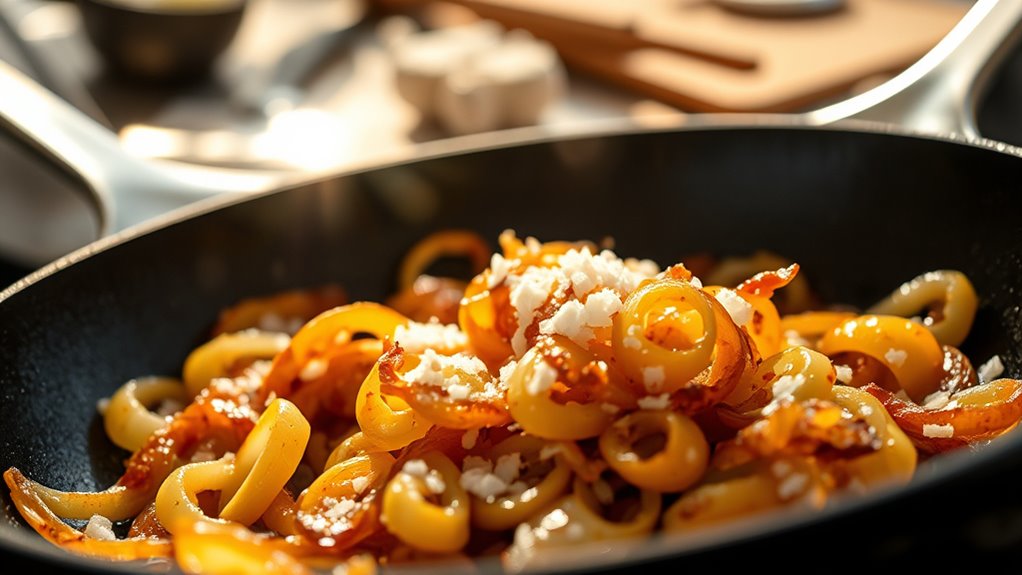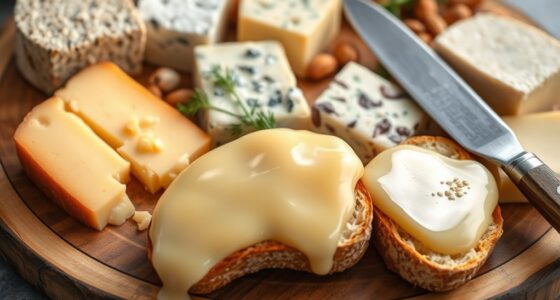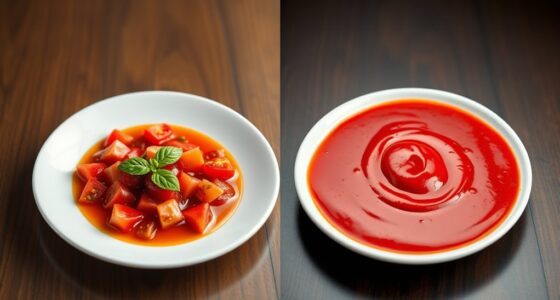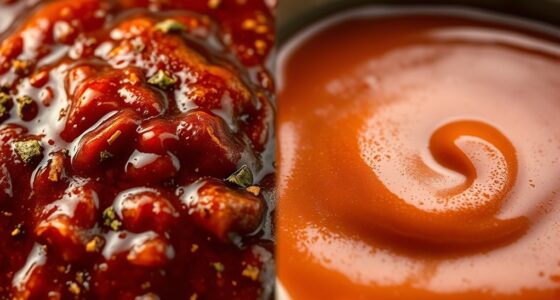Salt influences browning mainly by enhancing flavor and affecting moisture, which in turn impacts chemical reactions like caramelization and the Maillard process. Some myths claim salt always slows browning, but in reality, it can promote richer color when used properly. It draws out moisture, helps develop appealing crusts, and can even improve reaction efficiency. To get the best results, understanding how salt interacts with heat and moisture matters—continue exploring to master its true role.
Key Takeaways
- Salt can enhance browning by promoting moisture loss and surface drying, aiding caramelization and Maillard reactions.
- Myths that salt always slows browning are false; effects depend on salt concentration and cooking method.
- Proper salt levels help break down cell walls, releasing sugars and amino acids that improve browning and flavor.
- Excessive salt reduces moisture, risking dryness, but moderate salting can support even, appealing browning.
- Adjusting salt gradually during cooking allows better control over flavor and browning development.
The Chemistry Behind Browning and Salt’s Role
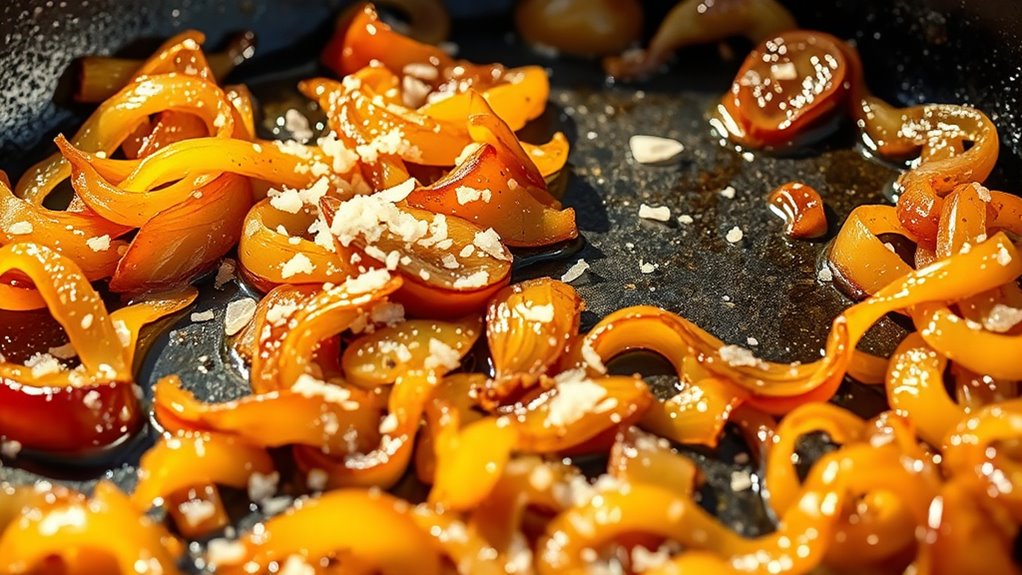
Browning during cooking occurs primarily through chemical reactions like caramelization and the Maillard reaction, which transform sugars and amino acids into new, flavorful compounds. These chemical reactions are essential for complex flavor development and color. Salt influences these processes by affecting how ingredients interact at the molecular level. When you add salt, it can enhance flavor by intensifying natural tastes, but it also plays a role in the chemical reactions’ efficiency. Salt can help break down cell walls, releasing more sugars and amino acids, therefore promoting better browning. This flavor enhancement occurs because the chemical reactions proceed more effectively with the right salt levels, leading to richer, more appealing browning. Understanding salt’s role helps you optimize the flavor and appearance of your cooked dishes.
Common Myths About Salt and Color Development
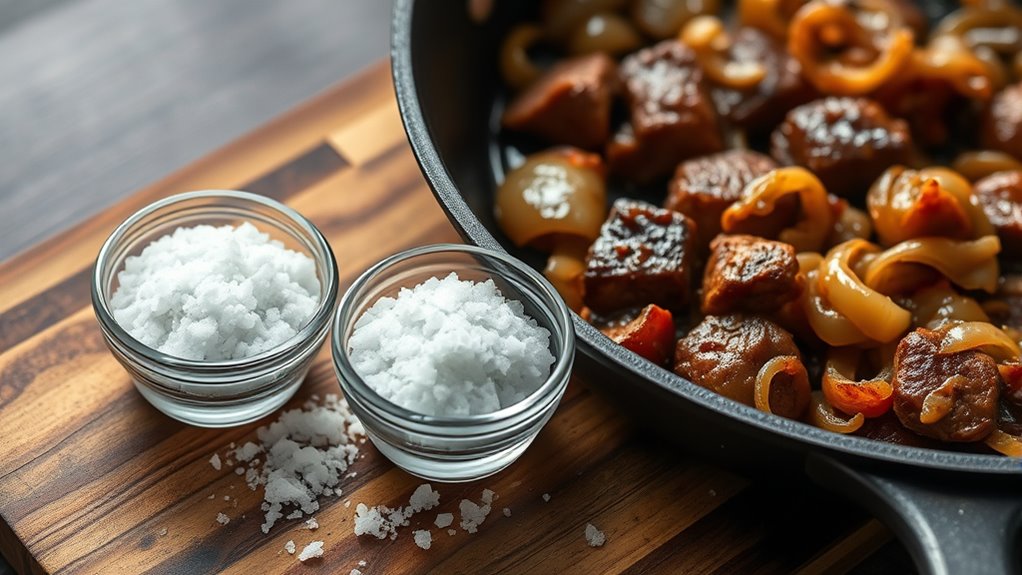
Many people believe that adding salt to food always slows down browning, but this is a common myth. Salt myths often suggest it suppresses caramelization and Maillard reactions, leading to duller color. However, this isn’t always true; salt can enhance flavor without hindering browning. Some color misconceptions stem from the idea that salt either accelerates or completely prevents browning, which oversimplifies how salt interacts with heat and moisture. In reality, salt’s effect depends on concentration and the specific process. It influences the surface chemistry, sometimes promoting more even browning, other times not affecting color at all. Understanding these nuances helps you avoid misconceptions and better control the development of color in your cooking. Salt’s role is more complex than simply slowing or speeding browning. Understanding these nuances can help chefs optimize their cooking techniques to achieve the perfect color and flavor balance.
How Salt Influences Moisture and Temperature
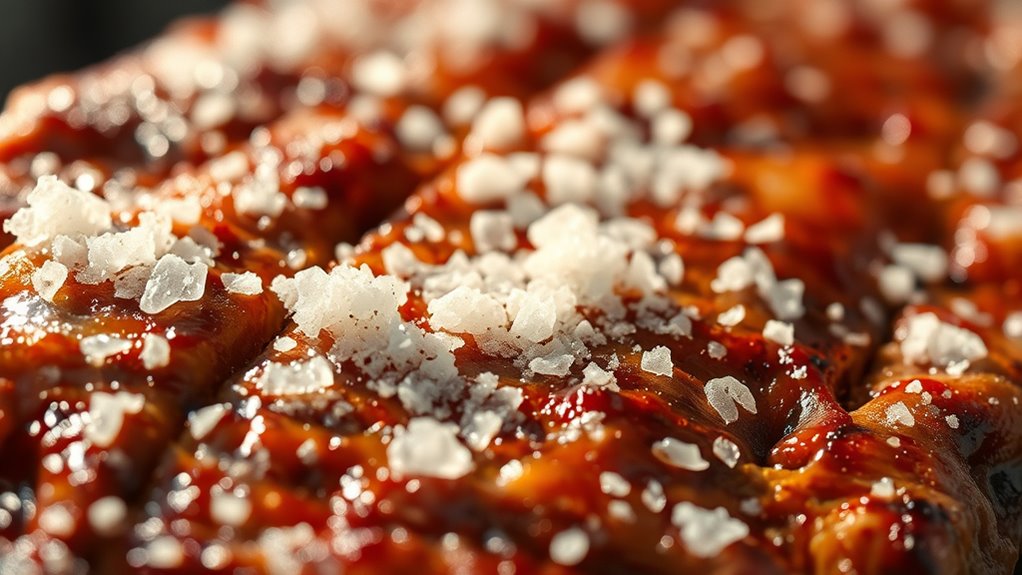
Salt considerably influences moisture and temperature during cooking by drawing water out of food through a process called osmosis. The salt concentration on your food’s surface determines how much moisture is lost or retained, impacting browning and texture. When you add salt, it initially pulls moisture to the surface, forming a brine that can enhance flavor and crust formation. However, too much salt can reduce moisture retention, leading to dry results. Conversely, moderate salt levels help maintain ideal moisture, promoting even browning. Proper salt management is essential for effective retirement planning, ensuring optimal results in your culinary process. Consider these effects:
Salt influences moisture and browning by drawing water out and forming a flavorful crust.
- Higher salt concentration can accelerate surface dehydration
- Proper salt levels improve moisture retention inside the food
- Excess salt may cause uneven browning
- Balanced salt enhances both flavor and even temperature development
Practical Tips for Using Salt to Enhance Browning
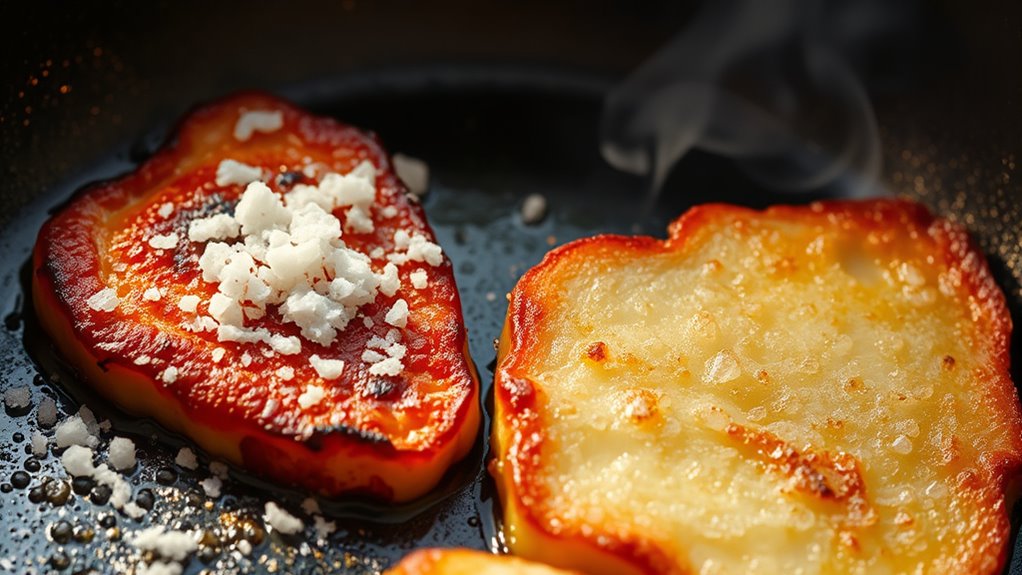
To effectively use salt for enhancing browning, start by seasoning your food evenly before cooking, ensuring the salt penetrates the surface without overpowering the flavor. Proper seasoning techniques involve sprinkling salt uniformly, which promotes consistent browning across the surface. Keep in mind that a light, even coating helps draw out moisture, aiding in caramelization and flavor enhancement. Don’t over-salt initially; you can always add more later if needed. Salt also helps improve the overall appearance by creating a more appealing crust. Remember, the goal is to enhance natural flavors while encouraging browning. By seasoning thoughtfully before cooking, you set the foundation for a more flavorful, well-browned dish, making salt an essential tool in your culinary arsenal. Additionally, understanding how drivetrain components function can help ensure your equipment performs optimally during cooking (or riding).
When and How to Adjust Salt for Perfect Results
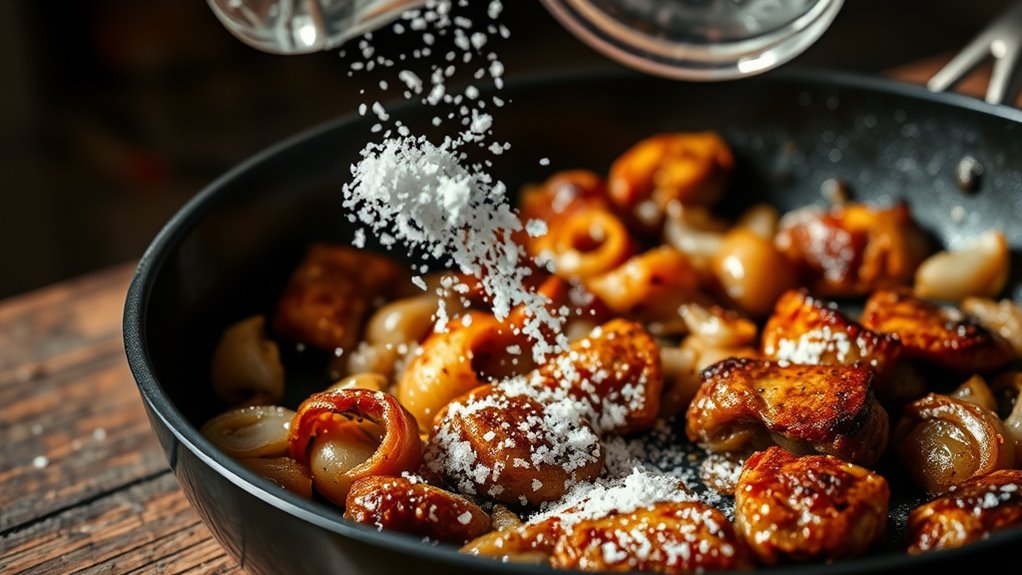
Adjusting salt during cooking is key to achieving the perfect level of seasoning and browning. When you add salt at the right moments, you enhance flavor and maintain proper seasoning balance. To do this effectively:
Adjust salt gradually during cooking to perfect flavor and browning balance.
- Taste your dish early and often to prevent oversalting.
- Add salt in stages, especially during long cook times, for even flavor.
- Consider the ingredients—moisture-rich foods may need less salt initially.
- Remember, a little salt can boost browning without overpowering the dish.
- Using the right type of salt and understanding how it interacts with heat can also influence browning and seasoning.
Frequently Asked Questions
Does Salt Affect the Nutritional Value of Browned Foods?
Salt doesn’t substantially change the nutritional value of browned foods, but it does add salty nutrients and minerals like sodium. When you season with salt, you’re enhancing flavor without drastically altering the mineral content. Keep in mind, excessive salt intake can impact health, so enjoy it in moderation. Overall, salt mainly influences taste and mineral content, not the core nutritional profile of your browned foods.
Can Salt Usage Prevent Burning During Browning?
Ever wonder if salt can stop your food from burning during browning? Yes, it can help—by improving heat transfer and moisture retention, salt delays the burning process. When you add salt early, it creates a barrier that slows down surface scorching, giving you more control. So, next time you’re worried about burning, try a pinch of salt; it’s a simple way to manage heat and prevent overcooking.
Is There a Difference Between Sea Salt and Table Salt in Browning?
Yes, there’s a difference between sea salt and table salt in browning. Sea salt usually has larger grain size and retains more mineral content, which can subtly influence flavor and how it interacts during cooking. Table salt has finer grains and fewer minerals, leading to a more uniform seasoning. These differences can slightly affect browning, but overall, both salts serve similar purposes in cooking.
How Does Salt Impact Browning in Different Cooking Methods?
Did you know that salt can increase browning by up to 50% in some cooking methods? When you salt food early, it improves salt penetration and moisture retention, leading to more even browning. In dry methods like roasting, salt enhances surface caramelization. Conversely, in moist cooking like boiling, salt’s impact on browning is minimal. So, adjusting salt timing and amount directly influences the final color and texture of your dish.
Does the Type of Salt Alter the Flavor of the Browned Product?
Yes, the type of salt can alter the flavor of your browned dish. Fine salt grains dissolve quickly, giving a uniform taste, while coarse salt offers a more subtle, textured flavor. Mineral content varies among salts like sea salt or Himalayan salt, adding unique nuances. So, consider salt grain size and mineral content when choosing your salt to enhance or complement the flavors of your browned foods.
Conclusion
Think of salt as a silent conductor in your kitchen orchestra, guiding the symphony of browning. When used wisely, it can turn simple dishes into masterpieces with beautiful color and flavor. But remember, too much or too little can throw off the harmony. By understanding salt’s true role, you’ll master the art of perfect browning—like a painter adding just the right touch of color to bring your culinary canvas to life.
